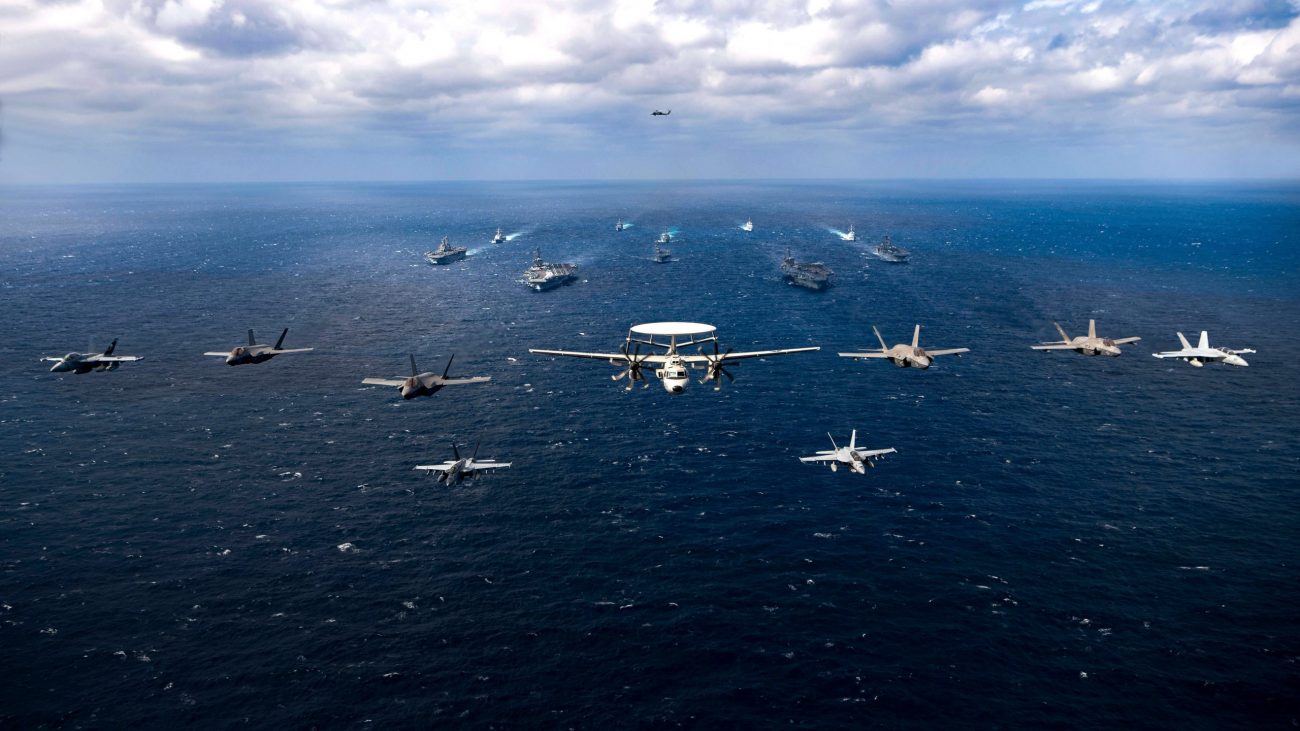China sent 39 warplanes into Taiwan’s air defense identification zone (ADIZ) on January 23, the largest such intrusion this year. Experts have termed it as an answer to US’ provocations in the region.
France ‘Joins The Club’ To Thwart Chinese Monopoly In The Indo-Pacific; Looks To Assert Power In The Region
The development was reported a day after the US and Japanese navies staged a massive show of strength in the Philippine Sea. A total of 26 F-35 Lightning II Joint Strike Fighters, two American aircraft carriers, two amphibious ships are among the military assets that were deployed for the war games.
This was the largest exercise featuring aviation-capable ships since October. The Philippine Sea lies east of Taiwan, between the self-governing island and the US territory of Guam and the Northern Mariana Islands in the Pacific Ocean. However, the US Navy made no mention of how close the fleet was to Taiwan.
With a total of 26 aircraft, the exercise was also the largest gathering of US naval F-35s to date. The participating aircraft carriers — Carl Vinson and Abraham Lincoln — carried 10 Navy F-35C fighters each while there were six F-35B short-takeoff, vertical-landing (STOVL) fighters were on the amphibious ship, USS American.
Moon’s Love For China’s Xi Jinping & North Korea’s Kim Jong-Un Casts A Shadow Over Seoul’s Alliance With Washington
Vice Adm. Karl Thomas, commander of the US 7th Fleet based in Japan said, “Freedom at its finest! Nothing reaffirms our commitment to a #FreeandOpenIndoPacific like 2 Carrier Strike Groups, 2 Amphibious Ready Groups sailing alongside our close friends from the Japan Maritime Self Defense Force.”
A US Navy statement said the mass of warships was “conducting training to preserve and protect a free and open Indo-Pacific region.”
The Financial Times reported that China has established a regular naval presence close to Japan’s Nansei Islands and eastern Taiwan. The communist nation sees the democratically governed island as a breakaway province that it wants to annex, if necessary, by force.
The latest muscle-flexing by the American navy in China’s backyard seems to have been aimed at sending a clear message to the PLA that the US and its allies would throw their weight behind Taiwan if it decides to launch a strike. Any potential conflict between the US and China would almost likely involve Japan as Tokyo indicated earlier.

China’s Aerial Incursion
In recent years, the PLA has increased the frequency of its aerial intrusions, claiming them to be part of military exercises. Nearly 150 planes were dispatched over four days in October 2021, shattering previous records.
The Taiwanese Defense Ministry said in a statement on January 23, 2022, that 24 J-16 fighter planes, 10 J-10 fighter jets, two Y-9 transport aircraft, two Y-8 anti-submarine warning aircraft, and one nuclear-capable H-6 bomber were involved in the latest incursion.
Taipei claimed it had scrambled fighter jets to chase away the Chinese jets. It gave radio warnings to PLA pilots and deployed missile defense systems to keep an eye on their activity.
The PLA’s planes went close to the contested Pratas Islands and the median line, an unofficial border that runs the length of the Strait between Taiwan’s main island and China. China seemed to toss aside a long-standing mutual understanding on the marker in 2020 when a foreign ministry official stated there was no such thing.
Chinese warplanes’ incursions occur days after Japanese Prime Minister Fumio Kishida and US President Joe Biden met virtually and agreed to “push back” against China’s aggressive measures in the region. Tokyo and Washington are also said to be working on formalizing a joint operations plan between their militaries to prepare for an emergency over Taiwan.
Collin Koh, Research Fellow at the S. Rajaratnam School of International Studies in Singapore, told CNN, “While the Chinese incursions Sunday were likely a reaction to the large naval presence Tokyo and Washington were putting in the area, they also served another purpose.” He claimed that this is part of a larger Chinese campaign aimed at weakening Taiwan’s will and ability to continue fighting.
“The latest major flyby, while obviously targeted at the allied show of force in the Philippine Sea, will definitely have some intended reinforcement effect on the ongoing debates in Taiwan,” Koh said.
China’s ‘Most-Dangerous’ YJ-12 Anti-Ship Missile Can Breach US Defense Systems, Taiwan’s Natural Barriers – Military
Taiwan maintains its sovereignty as a self-governing democracy. In response to Beijing’s threats, the country is beefing up its military through US aid and arms sales, although it faces hurdles.
It halted combat training for its F-16 fleet earlier this month after a newly upgraded model fell into the sea. PLA warplane incursions are said to be placing a lot of strain on the island’s planes and pilots.
- Contact the author at ashishmichel@gmail.com
- Follow EurAsian Times on Google News